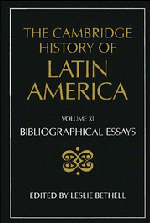Book contents
- Frontmatter
- I THE INDIGENOUS PEOPLES OF MIDDLE AND SOUTH AMERICA ON THE EVE OF THE CONQUEST
- II COLONIAL SPANISH AMERICA
- III COLONIAL BRAZIL
- IV THE INDEPENDENCE OF LATIN AMERICA
- V LATIN AMERICA: ECONOMY, SOCIETY, POLITICS, c. 1820 TO c. 1870
- VI LATIN AMERICA: ECONOMY, SOCIETY, POLITICS, c. 1870 to 1930
- VII LATIN AMERICA: ECONOMY, SOCIETY, POLITICS, 1930 to c. 1990
- 1 Population
- 2 The Latin American economies, 1929–1939
- 3 The Latin American economies, 1939–c. 1950
- 4 The Latin American economies, 1950–1990
- 5 Urban growth and urban social structure
- 6 Agrarian structures
- 7 State organization
- 8 Democracy
- 9 The Left
- 10 The military in politics
- 11 The urban working class and labour movements
- 12 Rural mobilizations
- 13 Women in twentieth-century Latin America
- 14 The Catholic church
- 15 The Protestant churches
- 16 Mexico, c. 1930–1946
- 17 Mexico since 1946
- 18 Central America
- 19 Guatemala
- 20 El Salvador
- 21 Honduras
- 22 Nicaragua
- 23 Costa Rica
- 24 Panama
- 25 The Panama Canal Zone, 1904–1979
- 26 Cuba, c. 1930–1959
- 27 Cuba since 1959
- 28 The Dominican Republic
- 29 Haiti
- 30 Puerto Rico
- 31 Argentina, 1930–1946
- 32 Argentina since 1946
- 33 Uruguay
- 34 Paraguay
- 35 Chile, c. 1930–c. 1960
- 36 Chile since c. 1960
- 37 Peru, 1930–c. 1960
- 38 Peru since c. 1960
- 39 Bolivia
- 40 Colombia
- 41 Ecuador
- 42 Venezuela
- 43 Brazil
- VIII IDEAS IN LATIN AMERICA SINCE INDEPENDENCE
- IX LATIN AMERICAN CULTURE SINCE INDEPENDENCE
- X THE INTERNATIONAL RELATIONS OF LATIN AMERICA SINCE INDEPENDENCE
- THE CAMBRIDGE HISTORY OF LATIN AMERICA
12 - Rural mobilizations
from VII - LATIN AMERICA: ECONOMY, SOCIETY, POLITICS, 1930 to c. 1990
Published online by Cambridge University Press: 28 March 2008
- Frontmatter
- I THE INDIGENOUS PEOPLES OF MIDDLE AND SOUTH AMERICA ON THE EVE OF THE CONQUEST
- II COLONIAL SPANISH AMERICA
- III COLONIAL BRAZIL
- IV THE INDEPENDENCE OF LATIN AMERICA
- V LATIN AMERICA: ECONOMY, SOCIETY, POLITICS, c. 1820 TO c. 1870
- VI LATIN AMERICA: ECONOMY, SOCIETY, POLITICS, c. 1870 to 1930
- VII LATIN AMERICA: ECONOMY, SOCIETY, POLITICS, 1930 to c. 1990
- 1 Population
- 2 The Latin American economies, 1929–1939
- 3 The Latin American economies, 1939–c. 1950
- 4 The Latin American economies, 1950–1990
- 5 Urban growth and urban social structure
- 6 Agrarian structures
- 7 State organization
- 8 Democracy
- 9 The Left
- 10 The military in politics
- 11 The urban working class and labour movements
- 12 Rural mobilizations
- 13 Women in twentieth-century Latin America
- 14 The Catholic church
- 15 The Protestant churches
- 16 Mexico, c. 1930–1946
- 17 Mexico since 1946
- 18 Central America
- 19 Guatemala
- 20 El Salvador
- 21 Honduras
- 22 Nicaragua
- 23 Costa Rica
- 24 Panama
- 25 The Panama Canal Zone, 1904–1979
- 26 Cuba, c. 1930–1959
- 27 Cuba since 1959
- 28 The Dominican Republic
- 29 Haiti
- 30 Puerto Rico
- 31 Argentina, 1930–1946
- 32 Argentina since 1946
- 33 Uruguay
- 34 Paraguay
- 35 Chile, c. 1930–c. 1960
- 36 Chile since c. 1960
- 37 Peru, 1930–c. 1960
- 38 Peru since c. 1960
- 39 Bolivia
- 40 Colombia
- 41 Ecuador
- 42 Venezuela
- 43 Brazil
- VIII IDEAS IN LATIN AMERICA SINCE INDEPENDENCE
- IX LATIN AMERICAN CULTURE SINCE INDEPENDENCE
- X THE INTERNATIONAL RELATIONS OF LATIN AMERICA SINCE INDEPENDENCE
- THE CAMBRIDGE HISTORY OF LATIN AMERICA
Summary
Three well-known attempts to build a typology of peasant movements in Latin America in the twentieth century are Aníbal Quijano, ‘Contemporary peasant movements’, in Seymour Lipset and Aldo Solari (eds.), Elites in Latin America (New York, 1967); Henry A. Landsberger, ‘The role of peasant movements and revolts in development’, in H. A. Landsberger (ed.), Latin American Peasant Movements (Ithaca, N.Y., and London, 1969), and Gerrit Huizer, El potencial revolucionario del campesinado (Mexico, D.F., 1973).
Other useful collections of articles on rural unrest are Rodolfo Stavenhagen (ed.), Agrarian Problems and Peasant Movements in Latin America (New York, 1970); Ernest Feder (ed.), La lucha de clases en el campo: Análisis estructural de la economía latinoamericana (Mexico, D.F., 1975), and Henri Favre (ed.), ‘Les mouvements indiens paysans aux XVIIIe, XIXe et XXe siècles’, Actes du XLIIe Congrès International des Américanistes (Paris, 1976). But the most complete and up-to-date collective work, including chapters on every Latin American country, is Pablo González Casanova (ed.), Historia política de los campesinos latinoamericanos, 4 vols. (Mexico, D.F., 1984–85). An illuminating synthesis is Henri Favre, ‘L’Etat et la paysannerie en Mésoamérique et dans les Andes’, Etudes Rurales, 81–2 (1981), 25–55. In a more abstract vein, a model for the changing nature of the rural social order and the increasing diversification of rural actors is provided by Eric R. Wolf, ‘Fases de la protesta rural en América Latina’, in Feder (ed.), La lucha de clases en el campo.
On the significance of caudillos and caciques, see the pioneering essays by Eric R. Wolf, ‘Aspects of group relations in a complex society: Mexico’, American Anthropologist, 58 (1956), 1065–78, and François Chevalier, ‘ “Caudillos” et “caciques” en Amérique: Contribution a l’etude des liens personnels’, Mélanges offerts a Marcel Bataillon par les hispanistes français, Bulletin Hispanique, 51 (1962).
- Type
- Chapter
- Information
- The Cambridge History of Latin America , pp. 634 - 647Publisher: Cambridge University PressPrint publication year: 1995

